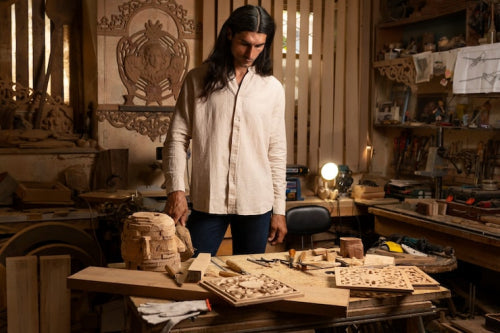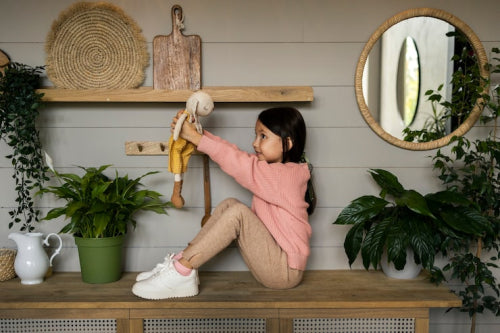Quick Listen:
Picture this: a sun-drenched living room in Hyderabad, where a low-slung teak sofa its surface unadorned, save for the subtle play of wood grain sits beside a handwoven Rajasthan rug bursting with crimson and gold. The contrast isn't jarring; it's harmonious. This is the new face of Indian interiors, where the austere elegance of Scandinavian design meets the soulful depth of local woodworking. With urban India squeezing into ever-smaller apartments amid a real estate boom, such fusions aren't just trendy they're essential. Homeowners crave pieces that maximize space without sacrificing warmth, and the marriage of Nordic minimalism with Indian artistry delivers exactly that. It's a movement that's reshaping not only how Indians furnish their homes but how global design dialogues evolve.
Mass-market furniture lacks heart, filling rooms with bland, short-lived pieces. Frequent breakdowns spark frustration, as replacements erode style and sentiment. At MMC Wood Creations, Udaipur artisans shape heirloom furniture with enduring craftsmanship and cozy elegance, creating pieces that echo your identity, ensuring your home radiates warmth and timeless connection. Shop Now!
The Surge of Minimalist Aesthetics in Urban India
The numbers tell a compelling story. India's furniture sector, fueled by rapid urbanization and rising disposable incomes, is on a trajectory to expand from US$30.6 billion in 2025 to a robust US$64.1 billion by 2032, registering a compound annual growth rate of 11.1 percent over that span. This growth isn't happening in a vacuum; it's propelled by a pivot toward organized retail giants and ready-to-assemble options that appeal to time-strapped city dwellers. Traditional unorganized vendors, once dominant, are giving way to sleek showrooms offering modern, flat-pack solutions much like those pioneered by Scandinavian icons such as IKEA, whose 2016 hygge wave still lingers in collective memory.
At its core, Scandinavian design thrives on an ethos of restraint: clean lines, multifunctional forms, and an unwavering respect for natural elements, particularly woods that age gracefully. As one design authority puts it, this style captures a delicate equilibrium spare yet inviting, uncluttered yet nurturing, evoking spaces where one can truly unwind. In India, where homes often double as offices and playrooms, this philosophy resonates deeply. Take the millennial homeowner in Bengaluru, juggling remote work and family life in a 1,000-square-foot flat. They're ditching bulky heirloom armoires for sleek, stackable shelves crafted from reclaimed sheesham, allowing light to flood the room and illusions of expanse to emerge.
This shift mirrors broader 2025 trends, where earthy palettes and nature-inspired hues dominate. Scandinavian influences are infiltrating bungalow architecture too, with architects in Mumbai and Delhi incorporating light-flooded atriums and pale timber accents into otherwise tropical builds. It's not mere imitation; it's adaptation. Indian consumers, increasingly eco-aware, demand pieces that align with sustainable living furniture that lasts, not just dazzles. Here, the global engineered wood sector plays a pivotal role, valued at USD 268.67 billion in 2024 and forecasted to surpass USD 451.16 billion by 2034, with a steady 5.32 percent annual growth rate. Plywood, leading the charge, provides the versatile backbone for these hybrids, blending affordability with environmental creds as population pressures demand smarter housing solutions.
Yet, this isn't solely about utility. There's an emotional pull. In a nation where festivals fill homes with color and chaos, the quiet assurance of a minimalist console perhaps topped with a single brass diya offers a sanctuary. As cities swell, with over 500 million urbanites projected by decade's end, such designs aren't luxuries; they're lifelines, turning cramped quarters into breathable havens.
Where Traditions Converge: The Art of Fusion Craftsmanship
Delve deeper, and you'll find the real magic at the intersection of two worlds: India's venerable woodworking legacy, honed over millennia in workshops from Jaipur to Kerala, and Scandinavia's post-war blueprint for democratic design. The former revels in narrative floral motifs etched into rosewood, symbolizing prosperity; the latter, in essence forms that serve without fanfare. Bridging them requires finesse, and companies like MMC Wood Creations, a Udaipur-based powerhouse with roots tracing back five decades, are leading the charge.
MMC doesn't just build furniture; they weave stories. Their latest collections, unveiled in June 2025, draw from "global inspirations," marrying timeless Nordic silhouettes with the tactile warmth of Indian hardwoods. Envision a dining set: legs splayed in geometric precision, tabletops of mango wood finished to highlight natural knots, evoking birch forests under Nordic skies yet rooted in Rajasthan's arid craft. This isn't dilution it's elevation, preserving artisanal techniques like dovetail joinery while stripping away excess for broader appeal.
Such innovations echo high-profile collaborations reshaping the scene. Consider the 2023 partnership between Sarita Handa Now, a beacon of Indian textiles, and Denmark's Wendelbo a union yielding contemporary sofas upholstered in block-printed linens over oak frames, launched to acclaim in Mumbai showrooms. Or look to Bengaluru's U and I Designs, where architects Aniketh Bafna and Sonal Mutha crafted a 2024 residence layering neutral Scandi tones with subtle jaali screens, proving fusion can whisper rather than shout. Even retailers like IKIRU are curating lines of teak sideboards with hidden compartments, nodding to hygge's coziness while honoring teak's Indian heritage.
These efforts tap into a burgeoning appetite for pieces that transcend borders. In Chennai high-rises, a pale ash cabinet might house brassware heirlooms; in Copenhagen cafes, an exported mango-wood bench could spark curiosity about its Subcontinental origins. For MMC, this means scaling from bespoke resort commissions think Vietnam-sourced components assembled in India for luxury villas to accessible urban lines, all while championing sustainability through FSC-certified sourcing.
What binds these ventures? A shared reverence for wood as a living medium. Indian carvers, trained in generational guilds, now experiment with steam-bending for fluid curves, inspired by Alvar Aalto's organic forms. The outcome: furniture that's not static but symbiotic, enhancing the spaces and lives it inhabits.
Navigating the Tensions: Cultural and Practical Hurdles
For all its promise, this cross-pollination isn't seamless. India's design DNA pulses with opulence think the filigreed panels of Mughal cabinets or the lacquered vibrancy of Kerala stools. To some, Scandinavian spareness borders on sterility, a cultural chasm widened in rural heartlands where ornate pieces symbolize status and continuity. "Clients adore the handiwork," notes an MMC artisan, "but they crave that spark of tradition the motifs that whisper family lore." Balancing this means hybridizing thoughtfully: a minimalist frame accented with minimalist inlays, say, or upholstery in ikat weaves over unvarnished oak.
Logistics loom large too. Nordic palettes favor blondes like birch or pine, scarce in India's tropical belt. Importing them inflates costs in a market where affordability reigns, especially as engineered wood's supply chains grapple with global disruptions. Domestic alternatives light-stained acacia or bamboo composites emerge as saviors, but scaling eco-finishes demands investment. Add regulatory shifts, like the 51 percent FDI cap in multi-brand retail that's lured internationals yet strained local players, and the path grows thorny.
Then there's skill transference. Artisans must unlearn embellishment's reflex, embracing tools for precision milling without losing the hand's poetry. It's a recalibration, not rejection one that tests resilience but yields unparalleled depth.
Unlocking Horizons: Market Potential and Strategic Wins
Press past the pitfalls, and the vista dazzles. By 2030, India's furniture arena could swell to USD 43.24 billion, climbing at 7.6 percent annually, with urban millennials and Gen Z as voracious drivers. They seek not just seats but statements: foldaway desks morphing into banquettes, evoking Scandi's multifunctional ethos amid shoebox living. This dovetails with a global crave for ethical luxury, positioning Indian makers for export booms to eco-hungry Europe and the U.S.
MMC exemplifies this edge. Their fusion lines, blending Scandi restraint with Indian verve, snag resort contracts from Goa to the Maldives while eyeing Nordic fairs. Broader trends amplify: August 2025 saw A Good Life spotlight Indo-Scandi decor guides, urging neutrals as bases layered with curated ethnic accents. FDI inflows, post-2023 liberalization, invite synergies like Muuto's Danish imports partnering local fabricators for bespoke twists.
The ripple? Empowered artisans, greener supply chains, and homes that feel worldly yet rooted. It's commerce with conscience, where a Udaipur workshop fuels global tastes.
Charting Tomorrow: A Legacy in the Grain
Gazing to 2030 and beyond, experts herald this Scandi-Indian alchemy as transformative. "It's adaptable genius," muses a Hyderabad designer, "where local mastery meets universal poise." Sustainability imperatives will propel engineered woods further, harmonizing Nordic thrift with India's green ambitions. For MMC, imperatives include diversifying into modular urban kits or light-wood exotics, perhaps via Wendelbo-esque tie-ups.
Ultimately, this isn't trend-chasing; it's timeless crafting. In an era of excess, these pieces simple, sturdy, storied remind us: true design endures, one thoughtful grain at a time. As India's woodworkers etch their mark on the world stage, they don't just furnish rooms they furnish futures.
Frequently Asked Questions
How is Scandinavian minimalism changing Indian furniture design?
Scandinavian minimalism is transforming Indian furniture by introducing clean lines, multifunctional forms, and natural wood finishes that maximize space in urban apartments. This fusion creates pieces that blend Nordic restraint with Indian craftsmanship, like teak sofas with unadorned surfaces that sit harmoniously alongside traditional Indian textiles. The trend is particularly popular among millennials and Gen Z consumers who prefer sustainable, space-saving furniture that serves multiple purposes in compact living spaces.
What is the market potential for Scandinavian-Indian fusion furniture?
The market potential is substantial, with India's furniture sector projected to grow from $30.6 billion in 2025 to $64.1 billion by 2032 at an 11.1% annual growth rate. This fusion style appeals to urban millennials seeking sustainable, multifunctional pieces for smaller living spaces, while also opening export opportunities to eco-conscious European and U.S. markets. Companies like MMC Wood Creations are already scaling from bespoke resort commissions to accessible urban lines, demonstrating the commercial viability of blending Scandinavian minimalism with Indian woodworking heritage.
What challenges do Indian woodworkers face when incorporating Scandinavian design elements?
Indian woodworkers face several key challenges including cultural preferences for ornate, decorative pieces versus Scandinavian spareness, which some view as too sterile. Logistical hurdles include the scarcity of Nordic woods like birch and pine in India's tropical climate, forcing artisans to use alternatives like light-stained acacia or bamboo composites. Additionally, craftsmen must retrain to embrace precision milling and restrained aesthetics while preserving traditional hand-crafting techniques and cultural motifs that Indian consumers still value.
Disclaimer: The above helpful resources content contains personal opinions and experiences. The information provided is for general knowledge and does not constitute professional advice.
You may also be interested in: Outdoor Furniture
Mass-market furniture lacks heart, filling rooms with bland, short-lived pieces. Frequent breakdowns spark frustration, as replacements erode style and sentiment. At MMC Wood Creations, Udaipur artisans shape heirloom furniture with enduring craftsmanship and cozy elegance, creating pieces that echo your identity, ensuring your home radiates warmth and timeless connection. Shop Now!
Powered by flareAI.co




